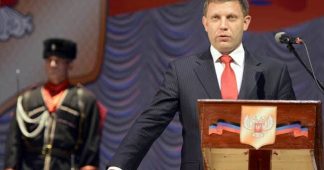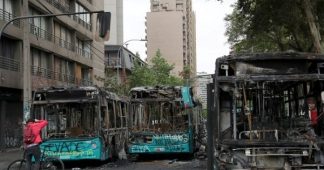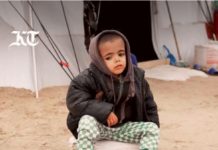Eva Bartlett traveled to the besieged Donetsk People’s Republic to see firsthand how residents are faring amidst a western-backed Ukrainian incursion.
by Eva Bartlett
October 16th, 2019
On September 2, I left the southern Russian city of Rostov-on-Don via minibus heading northwest to the border of the Donetsk People’s Republic (DPR) and on into Donetsk. For my first few days there, I rented an inexpensive apartment in the heart of the city. Walking on a long tree-lined and cafe-filled pedestrian walkway, life seemed normal. But I would soon find that for the people living in Donetsk, it is anything but.
I passed a cafe where a former DPR leader and military commander, Alexander Zakharchenko, was assassinated by a remotely detonated bomb in August 2018. He was beloved, and as I stood there, two women stopped to pay respects and pray.
Days later, at a transit hub in Donetsk, I met with Alexey Karpushev, a resident of the northern city of Gorlovka, an area hard-hit by Ukrainian bombing, and whose outskirts continue to be shelled near-daily.
A long line of mostly students extended around the corner waiting for the next available minibus to Gorlovka. After an hour of waiting, the minibus arrived and we boarded for the bumpy ride north.
Alexey deposited me at a hotel, a rambling Soviet-era structure just off a pedestrian area that during the evenings becomes crowded with families, lovers and friends strolling, and children bicycling.
In the morning he took me to a central park where a chess tournament was taking place. For the next five hours, fourteen adults and eight children played chess. A hundred meters away, an old but functioning children’s park with small amusement rides attracts more kids as the morning morphs into the afternoon.
In the tranquility and normalcy, it was hard to believe that Gorvloka’s central areas were terrorized by Ukrainian-fired bombs just a few years prior. “Summer 2016 was last time city center was bombed,” Alexey would tell me later. “We still hear the shelling, but it’s on the outskirts. People are sniped there, too.”
Gorlovka was hardest hit in 2014, especially on July 27, when the center was rocked by Ukrainian-fired Grad and Uragan missiles from morning to evening. After the dust settled and the critically-injured had succumbed to their wounds, at least 30 were dead, including five children, Alexey tells me. The day came to be known as Bloody Sunday.
Alexsey and I walked around the city, where he showed me the Bloody Sunday sites. We passed a busy bus stop on a busy street where residents were amassed waiting for their buses. This bus stop was one of the Bloody Sunday sites. As Alexey told me:
“The largest number of victims happened near this bus stop. There were mainly babushkas (grandmothers) here, selling flowers and vegetables. They came under Grad strikes and they died.”
Hero Square, not far away, also came under fire: “There was mainly youth there, students. Several people died from the blasts, including the ‘Madonna of Gorlovka’, Kristina Zhuk, with her infant daughter Kira.” A mural just near the main city square depicts Kristina and Kira on Bloody Sunday, rising above the plumes of smoke and the bloodbath.

Not far from the bus stop, a monument commemorates the Gorlovka victims of Ukrainian bombings and sniping from 2014-2017. Near a sculpture of an angel, over 230 names fill the marble slabs, the first dedicated solely to children, 20 of them.
We walked on to Hero Square, the tree-filled park where Kristina and Kira were killed. In its center is a monument to those who died fighting in WW2.
As we stood near a tank installed “in honor of militiamen who died defending Gorlovka against Ukrainian troops from 2014 up to this very day,” we both remark on the irony: the park contains a monument to those who died fighting against Nazis in WW2, and a memorial to those killed by Ukrainian neo-Nazis from 2014 and on.
The following day, we visited the Soviet Army Square in central Gorlovka, where a ceremony was taking place marking the 76th anniversary of the liberation of Donbass from Nazis on September 8, 1943. While they commemorate the victory of decades ago, they have the memories of bombings by the Ukrainian forces in recent years. The outskirts of Gorlovka and surrounding areas continue to be shelled by Ukrainian forces.
The Mayor of Gorlovka agreed to meet with me. He told me he does his best to keep people informed, via his Telegram channel, with daily updates (in Russian) on Ukrainian bombings and violations of the ceasefire agreement (the latest having come into effect on July 21). After our meeting, he opened a second Telegram channel in English.
Censored Ukrainian war crimes
I received permission to enter some of the areas targeted by Ukraine and did so on September 12.
Just a few days prior, the Donetsk News Agency, citing a report from the DPR Office at the Joint Centre for Control and Coordination, reported:
“In the period from September 2 to September 8, 86 ceasefire violations by Ukrainian armed formations were recorded. Overall, 918 rounds of ammunition were fired (8.5 tons or 99 boxes)…
[T]he enemy fired at the DPR 40 152mm artillery rounds and more than 260 120mm and 82mm mortar rounds. Two civilians were wounded and 23 houses and infrastructure facilities were damaged in the shelling.”

I was met in Gorlovka by Dmitry Astrakhan, a press officer in the DPR People’s Militia, who is fluent in English. He tells me we will go to a former mining area just northwest of the city, a village known as Mine 6-7, and also to Zaitsevo, a front-line village north of Gorlovka that has been hard hit by Ukrainian shelling.
As we drive, he advises me:
“When you hear the whistle of a mortar, drop down immediately — to avoid the spray of shrapnel. Also, don’t go off the road: most areas haven’t been checked for unexploded ordnance.
Ukraine uses drones to drop explosive devices: it’s impossible to tell which drones are carrying out reconnaissance and which are armed with bombs. If someone yells ‘air attack,’ you need to run to find a shelter with a roof. When you hear the ‘outgoing’ call from the spotter, you have 10 to 15 seconds to run to a shelter.”
He explained the range of some of the heavy artillery Ukraine uses:
“The 152 mm has a 25 km range. The Uragan multi-rocket launcher has a 30-40 km range. The Tochka heavy rocket/missile has a 100 km range. They stopped using the heavy artillery 152 mm for a while, but a week ago they destroyed many houses in three villages in the south of the DPR. They were 12 km from the front-line. It was around 5 a.m.; there were some people injured but no one killed. But a lot of houses destroyed.”
I asked Dmitry how he got involved with the DPR Press Office, as he had told me he wasn’t a journalist prior to the war.
“I had a normal job and life. I wasn’t very political. In the beginning, people were mainly just struggling for our rights: the right to speak our language, Russian; the right to have education in our language, to keep the memory of WW2 — because Ukraine started re-writing history. They now consider those Ukrainian nationalists who collaborated with German Nazis heroes, and the Red Army occupiers. We can’t accept this.
I never believed there would be a war, I didn’t believe the Western world would allow this. I thought it would just be some protests, some compromises, but not war. I thought people were being paranoid at first, thinking we would be killed. But they were right, and when the war started, I knew there were things worth fighting for.”
He spoke of how Ukraine hides its shelling from the Organization for Security and Cooperation in Europe (OSCE) observers by doing most of it after hours (in the dark, when it is difficult to film) — later claiming that damage done to the DPR side was self-inflicted, or that Ukrainian forces were merely defending themselves, replying to DPR attacks:
“The OSCE were attacked a week or so ago by a heavy anti-tank rocket launcher. Ukraine commits many war crimes, but manages to mask it. They are Nazis, but they mask this from the West. Few people understand in the West how close Ukraine is to becoming a full-on Nazi state.
They say that they are from Bandera Front, they are Ukrainian far-right nationalists. When a person from some Western country hears about Bandera, this person could not understand what Ukrainian authorities mean. But I do, I understand what they mean, I understand who Bandera was and what they really mean.”
Stepan Bandera was a Ukrainian political figure, Nazi collaborator, and one of the leading ideologists/theorists of the Ukrainian nationalist movement of the 20th century. Dmitry continues:
“There is a Nazi state in the middle of Europe in the 21st Century. They are dangerous both for us and for the Western world. If they finish with us, they will do the same in the Western world.
Ukraine has a big propaganda machine, and the censorship of Western media helps.
I was raised believing in the Western ideals of human rights and democracy. And what do I have? I have no human rights. Ukrainian Nazis can kill me and they can go to the European Parliament and they will be considered heroes. They can kill without court, without justice, without anything.
Western countries support war crimes, support the killing of our people just because we speak our native language, Russian. That’s the only reason to kill us, just because we like Russia and speak Russian.
They can kill you. They consider all the journalists as Russian propagandists. Their military can shoot you and never face justice. That goes against my understanding of human rights.”
Mine 6-7 Area residents terrorized nightly
“Don’t film the soldiers with us,” Dmitry instructed as we drove. “They are afraid for their families because the Ukrainians sometimes take the families of the military as hostages.”
The road was overgrown with weeds, grass, and unpruned tree limbs. Maintenance is impossible during wartime. The positive side is that in areas close to the frontlines, such growth prevents snipers from seeing people are on the road.
“We’re very close to the front line,” Dmitry announced.
We got out of the car and walked down the lane to the first of a few houses in the area. Some residents agreed to have their testimonies recorded on video; others did not, believing that if Ukrainians saw their houses published on video, they would be targeted. Others are still worried about repercussions when they make the monthly, time-consuming trek to Ukraine to receive their pensions (involving slow bus travel, long lines, and the fear of being singled out for having spoken to journalists about their lives under Ukraine’s war).
A spunky 74-year-old woman, whose home has been shelled on more than one occasion, agreed to be filmed and took me to the back of her house to show me the latest damage. There were two strikes there; her basement is destroyed. The outer wall of her house is damaged and leaning. She worries the wall will collapse, as with a similarly damaged front wall, and worries about how she’ll be able to patch up the damage before winter comes. She lives alone.
“I’m afraid at night; that’s when they start shelling heavily,” she tells me. The nights are terrifying, hell for her. I ask if she ever considers leaving. “To where? I have nowhere to go. My husband is dead.”
Read more at https://www.mintpressnews.com/under-fire-from-ukraine-everyday-life-in-the-donetsk-peoples-republic/262363/











